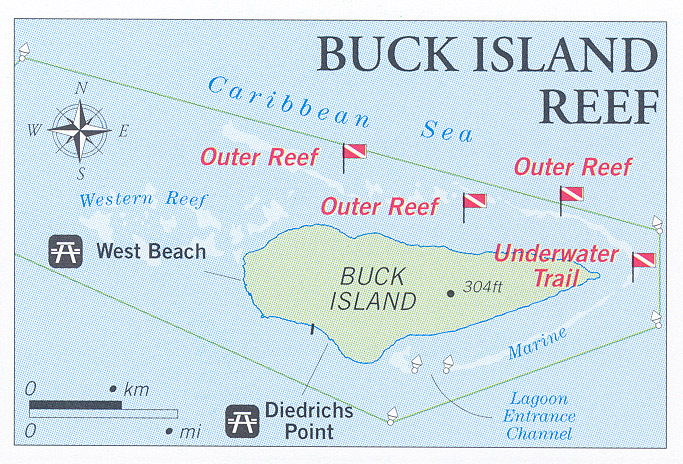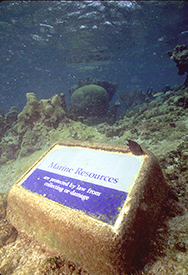Diving in Buck Island Reef National Monument
Buck Island Reef is a small island created along with St. Croix by the action of plate tectonics and sedimentary uplift. It lies five miles northeast of St. Croix. The 880-acre reserve includes the island, surrounding barrier reefs, and an inshore lagoon. This small, comparatively sheltered piece of marine real estate was first protected as a park in 1948. It was transferred to the National Park Service in 1961. Like Trunk Bay on St. Thomas, it holds special significance for park lovers because it is one of the first areas set aside for its underwater values. It has traditionally been managed in association with nearby Christiansted National Historic Site which contains fortifications dating to the 1700s when St. Croix was part of the Danish West Indies.
Buck Island is known for some of the most spectacular stands of elkhorn coral that can still be found in the Caribbean-even after September 1989, when Hurricane Hugo paid a visit to the island bringing with it 25-foot waves and 200-mph-plus winds. The more robust corals, such as brain and star coral, remained intact, but parts of the magnificent elkhorn forests of Buck Island were reduced to rubble. Fortunately, much of the elkhorn barrier reef still remains intact.
Damage is evident but the diving is still very worthwhile, indeed instructive in its own special way. Diving Buck Island will give the diver a new appreciation of how nature recovers from natural disasters. The dead tumbled parts of the barrier reef are now covered with algaes working to recement the reef back together. Look closely, and you will see new coral growth emerging; much the same as the new seedlings that push their diminutive green heads up through charred snags after a forest fire.
BASICS
Location: Islet near St. Croix in the Virgin Islands
Skill level: Beginner-intermediate
Access: Boat
Dive support: At the Salt River Bay marina and allover St. Croix
Best time of year: Anytime is good
Visibility: 50 to 100 feet
Highlights: Coral reefs, abundant marine life
Concerns: Strong currents
Rules and Regulations
Dive Site Map
Dive Overview
Diving Buck Island is about as easy as falling off a three-legged stool. You take a charter boat from the dock at Christiansted, and after a short ride northeast (40 minutes by power boat) across the channel the boat slides in behind the barrier reef, offering a calm anchorage even when the afternoon trade winds pick up to 20 knots. Pick up a mooring at the scuba area, suit up, and falloff into a swimming-pool-tame environment full of fish, corals, and sponges. On scuba or snorkel you can explore the shallow lagoon or venture along the coral barrier reef and out among the maze of coral grottos. Snorkeling, you can follow a marked underwater trail. You may want to make advanced reservations with one of the concessionaires authorized to offer trips to Buck Island Reef NM. Concessionaires depart from Christiansted Waterfront or Green Cay Marina. Boat sizes and passenger limits vary from one concessionaire to another. Full and half day charters are available. More information is available at the Buck Island Reef National Monument website.
Dive Sites
THE UNDERWATER TRAIL
This marked trail, reserved for snorkelers, will lead you across huge shallow coral heads that come just short of breaking the surface. It then continues through a coral-lined grotto to the outside of the barrier reef. Here the bottom drops away to about 25 feet, and you look back to a solid wall of coral offset against a pearl white sand bottom. The markers will point out things of interest along the way. Looking back at the barrier reef from the seaward side you will be able to appreciate the extent of the destruction wrought by Hugo. Huge chunks of elkhorn reef lie stacked up like cord wood or tumbled in ragged piles along the barrier reef.
OUTER REEF
The underwater trail is ideal for snorkeling, but diving is good just about anywhere you see reef. At depths of 15 to 45 feet, the conditions are perfect for new divers and diverse enough to be interesting for the seasoned pros. There are two moorings dedicated to scuba activities north of the Underwater Trail, so you shouldn't have to use an anchor. By picking your way carefully along through the coral you can find a surge channel that will lead you to the outside reef. Just be sure to make mental note of some landmarks so you can find the same channel to return through after you finish your dive. DO NOT attempt to swim over the shallows of the reef to get back to the lagoon. The reef crest is typically covered with fire coral, so you will likely damage the fragile coral and hurt yourself in the attempt. There are lots of passages through the barrier reef and since the diving is shallow you can come up to the surface to orient yourself frequently.
If you’re lucky, you may find at Buck Island a chance to share an underwater world on an intimate level with one of its most appealing native creatures. During one dive, JB had a small hawksbill turtle for a dive buddy. It curiously followed him around checking out everything he investigated. Buck Island is one of the very few places in the United States where hawksbill turtles still nest, so the presence of young turtles isn’t unusual, but very special nonetheless. Later the same day while snorkeling off one of the island’s spectacular beaches, we were joined by a couple of spotted eagle rays that soared around us like stunt pilots out for a joy ride.
DIVING RULES AND REGULATIONS
Diver-down flag must be displayed while divers are in the water.
No collecting of natural or cultural resources including coral or artifacts.
Spearfishing is prohibited in the Marine Garden and highly regulated elsewhere.
Scuba diving is allowed in two designated areas only. It is prohibited on the lagoon and along the Underwater Trail.
Last Updated: October 26, 2012







